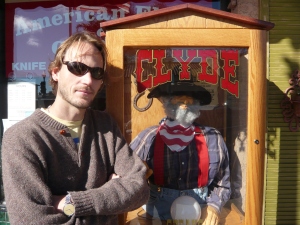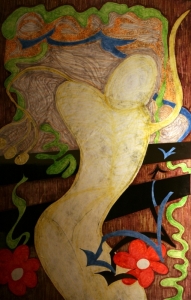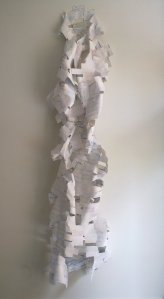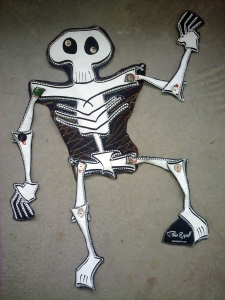Pete Ippel does not do many of the things one might expect of a young artist. For one, he doesn’t live in a decrepit studio apartment in some burgeoning neighborhood nearing gentrification in some crowded metropolitan area—at least not anymore. He doesn’t brood. He doesn’t smoke—anything. He doesn’t dismiss disagreement or criticism with haughtiness. And he doesn’t passively wait around for success or acclaim: he creates it.
“September 1 marks the half-way point of my 64 week accelerated art plan.”
Pete’s Facebook status usually gives a blow-by-blow account of his efforts and successes in both art and life. I have insider knowledge about his 64-week accelerated art plan, so I know it’s less romantic an endeavor than it might otherwise sound. As Pete explains, his 64-week plan is like an athletic training regimen or a multi-phased business plan, complete with benchmarks and deadlines.
In the interest of full disclosure, I should reveal this tidbit: Pete and I have been close friends for over a decade. We met as naive pimple-faced teenagers in college where we did our fair share of navel gazing, philosophizing and the like. Pete received two degrees from our university: a BFA in art and design, and a BA in psychology. Sometime after college, we both found ourselves living in San Francisco, where Pete completed a MFA program and embarked on his career as a professional artist.
As a practical matter, though, Pete did not dedicate all of his time to art while he was living in San Francisco. Because he had bills to pay, he had to work—as a program manager for the San Francisco Ballet Academy, as a personal trainer with the YMCA, as a basketball coach for University High School. Nevertheless, Pete was periodically commissioned to create various pieces and it was during his years in San Francisco, in fact, that he made one of my favorite pieces, “The Fantastic Solution to Global Warming,” a colorful dreamscape of what we just might do with all of that carbon dioxide in the atmosphere: capture it using a giant siphon in the sky and compress it down to brilliant, conflict-free diamonds. Of course.
In 2009, Pete heard about a new artistic residential program that was being created in, where else, Ventura, California. Working Artists of Ventura, or WAV, is a joint venture between public and private interests aimed at coordinating, fostering and integrating an artistic community into Ventura. Selected artists get to live inside of spacious lofts that double as personal gallery spaces. The lofts are housed inside a “green” LEED-certified residential complex complete with a community theatre and other spaces. The top floor lofts are reserved for private purchasers, just another grace note in the program’s efforts to integrate the artists with the larger community.
Pete applied to the WAV program, never having spent any significant time in Ventura. When he was asked to interview for the program, he rented a car in San Francisco, spent most of the night driving to Ventura, interviewed with the program coordinators, and drove back that next day. Once accepted to the program, he threw caution to the wind and packed his room full of belongings—clothes, supplies, books, work, memories—and made the permanent 300 mile trek down south.
As he explains, the move was both liberating and frightening—liberating because he gave up all steady work commitments for an abundance of work space, peace and time; frightening because he gave up all steady work commitments. His only sources of income were what already sat in his account and his artwork. Hence, Pete’s response to the challenge: a multiphase 64-week program involving intense production and self promotion. Pete began accounting for every hour of his day to ensure at least eight were spent working. He set production goals, printed business cards, polished his “elevator pitch,” re-worked his blog, and assiduously tracked and reached out to all persons in his growing network.
“I solve problems. I think abstractly. I make decisions.”
Pete’s efforts paid off. He recently installed a piece commissioned by a couple who sought an artistic solution to a practical problem. The couple had recently purchased a new home and wanted to install a divider between the master bedroom and the adjoining bathroom. Though they wanted the divider to separate the two spaces and create some privacy, they also wanted it to allow natural light from the bathroom into the living room, all while reflecting some artistic qualities. Also, because the divider would be installed adjacent to a bathroom, it had to resist moisture.
Pete solved the problem—by using innovative materials like Tyvek and by developing new ways of manipulating the material. The result is a translucent, waterproof panel that is also a two-sided canvas depicting images of fertility and growth, themes that were important to the young couple.
“I’m in the business of communicating ideas.”
I understand why Pete does what he does. Or at least I think I do. I’ve seen him work on pieces. I’ve heard him discuss completed projects. I’ve listened to him explore new concepts. I’ve seen his eyes flash when discussing someone else’s work or ideas. I’ve seen the fanciful doodles and word associations scrawled in his notebook. The guy is truly tickled by all of the mysteries art allows, indeed invites, him to explore.
But Pete is less interested in the solo expedition. He is more interested in engaging his audience with ideas and creating a dialogue. This dialogue, he says, is critical to the cycle of creating compelling art. Thus, even Pete’s most abstract pieces are anchored in a concrete idea and invite dialogue.
Pete is so serious, in fact, about generating critical discourse through art that he started organizing monthly talks on a variety of topics—“why I do what I do?”, “ethics and morality”—that are not directly related to art, but will nurture, Pete hopes, Ventura’s artistic community. As he acknowledges, Ventura attracts a number of artist Now, he says, it is a matter of getting the artists and the art to talk to each other.
Critics, too. I recently had a very candid discussion with Pete about some of his earlier art projects. One piece in particular, I told him, confused me because it looked to me like a child’s furious scribble. As I explained to him, I thought perhaps he was toying with my sense of perception to see if I could bring myself to be critical about a piece done by a highly educated artists and a close friend. He laughed, but he assured me that was not his intent. He acknowledged that the piece in question was inferior on a technical level. But, he explained, art does not require technical prowess at every brush stroke.
Pete’s interdisciplinary approach to art is itself remarkable. And it is overshadowed only by the art itself. Pete’s artwork evades description in much the same way complex concepts resist singular definition. For one, Pete does not confine himself to any one medium. To be sure, he works plenty with two-dimensional representations on paper, but even that repertoire is diverse: he has used watercolor, ink, even wax, all on materials ranging from butcher paper to Tyvek.
Then there is Pete’s 3-dimensional work, like “The Absence” and “Checkered Past,” both of which were born out of significant introspection. “The Absence” challenges viewers to reconsider the aesthetic qualities of materials normally reserved for displaying art—wooden frames, wines, tubing—by stripping away the contents of these framing devices and balancing them in intricate arrangement that only hints at the potential energy bound up within each frame and wire. “Checkered Past” reflects a longer personal history for Pete. It involves an extensive collection of blank checks from various bank accounts Pete had opened earlier in life. Each account is indicative of a phase: from the little track man with Olde English font printed on recycled paper when he was 18 to the iconic deer, pheasant and bears from Ithaca to the soaring golden-embossed eagle of First Republic Bank in San Francisco. Upon moving to Ventura, Ippel wanted to simplify, closing all the accounts, and rendering the checks void. What is one to do with an extra 1500 pieces of paper? Recycle.
“Art is the most practical, essential, and exciting field of work in the world today, and I look forward to sharing it with you.”
I once made the mistake of asking Pete to define art. I say mistake because his answer far exceeded all of my preconceived notions. Because rather than talking about form, context, intent, technique, he talked about practical decision-making. I’ll be the first to admit, my head is just too small to wrap around the looming implications. Pete, on the other hand, seems happy to relish them. If you don’t believe me, consider this: Pete was recently commissioned by the Ventura County Museum to design a tee-shirt for their Dia de los Muertos event last weekend. He designed the shirt alright. But there was more to it than just a simple graphic design. To move the shirt beyond its normal life expectancy as a wearable garment, Pete incorporated a subversive suggestion in his shirt design: that its wearer should destroy the shirt and create their own art. He did this by making one simple decision: he included dotted lines and a small image of some scissors on the shirt design. So Pete’s shirt, for example, became:
Does that make you smile or even laugh? If not, then how does it make you feel? Because I bet the answer to that question is what Pete would be most interested in hearing.





You must be logged in to post a comment.